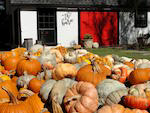 July 17, 2023 - Despite heat and drought, the “fall” vegetable season begins in July, with the planting of tomato transplants (if you can find them) and pumpkin seeds. Growing pumpkins here is not for the faint of heart, but what would Halloween be without them? There are several obstacles in your way, including powdery mildew, viruses, and squash vine borers.
July 17, 2023 - Despite heat and drought, the “fall” vegetable season begins in July, with the planting of tomato transplants (if you can find them) and pumpkin seeds. Growing pumpkins here is not for the faint of heart, but what would Halloween be without them? There are several obstacles in your way, including powdery mildew, viruses, and squash vine borers.
Pumpkins require warm soils to germinate. They cannot tolerate frost or freezes. To produce a fall crop of Jack-o’-lanterns, plant the seed approximately four months (mid-July) before the first killing frost. Different varieties have different number of days to reach maturity, so be sure to check the variety description and add about 25 days for slower maturity in the fall. Pumpkins should be planted in hills 4 to 6 feet apart and thinned to the strongest two plants seven to ten days after sprouting.
Pumpkins require at least eight hours of direct sun each day for maximum production. They are not choosy about soils as long as it drains well. Ideally, till in several inches of compost and incorporate two pounds of a complete lawn fertilizer (15-5-10, 18-6-12, etc.) per one hundred square feet of bed or every thirty-five feet of row before planting. The ideal soil pH for growing pumpkins is 6.0 to 7.5.
Pumpkins are direct seeded into the garden and make exceptionally large plants around 6 or more feet in diameter. Create a raised row about six inches high and twelve inches wide. Multiple rows should be around eight feet apart. Pumpkin seed should be planted in groups of seed every six feet. This is known as planting in hills. Open a shallow depression about one inch deep and four inches wide with a hoe. Drop four to five seeds evenly spaced apart in the hole and cover lightly with loose soil using a hoe or garden rake. Reliable irrigation is essential as they will need about 1 to 1.5 inches of water per week until fall rains arrive.
About three weeks after thinning your pumpkins, apply an additional application of fertilizer. This is known as side-dressing. Sprinkle two tablespoons of a high-nitrogen fertilizer (21-0-0, etc.) around each hill, being careful to keep it off the plants. Work the fertilizer into the soil lightly with a hoe or rake and water thoroughly. After side-dressing, it is ideal to apply a layer of organic mulch (hay, straw, grass clippings, etc.) to conserve water and prevent weeds. The most common pest problems on pumpkins are cucumber beetles, squash bugs, white flies, squash vine borers, powdery mildew, and viruses. Control the insects as they occur with appropriately labeled insecticides following all label directions. There is no cure for a virus but controlling the insects spreading it will help lessen its occurrence.
Pumpkins should be ready to harvest 90 to 120 days after planting the seed, depending on the variety. The pumpkins are ripe when they are fully colored and have a hard rind and a woody stem. Cut the pumpkin from the plant with a pair of hand pruners leaving a 3 to 4-inch stem on the fruit. Fall pumpkins can tolerate frosts without damaging the fruit but should be harvested and protected if the temperatures are going to dip below 30 degrees.
Recommended pumpkin varieties in Texas include ‘Big Max,’ ‘Connecticut Field,’ ‘Funny Face,’ ‘Jack-B-Little,’ ‘Jack O’Lantern,’ ‘Jackpot,’ ‘Small Sugar,’ and ‘Spirit Hybrid.’ Pumpkins are native to Central and South America.
Greg Grant is the Smith County horticulturist for the Texas A&M AgriLife Extension Service. He is the author of Texas Fruit and Vegetable Gardening, Heirloom Gardening in the South, and The Rose Rustlers. You can read his “Greg’s Ramblings” blog at arborgate.com and read his “In Greg’s Garden” in each issue of Texas Gardener magazine (texasgardener.com). More science-based lawn and gardening information from the Texas A&M AgriLife Extension Service can be found at aggieturf.tamu.edu and aggie-horticulture.tamu.edu.








